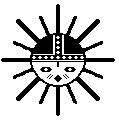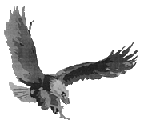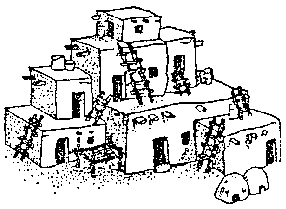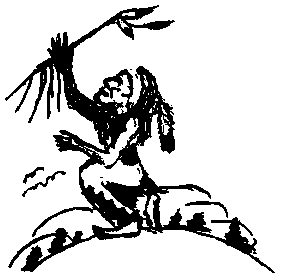 |
Soaring
Eagle Sentinel
|
Sponsored by: Southern California American Indian Resource, SCAIR
Friends:
These are Soaring Eagle storytelling tales to be told and retold. All tribes have their own stories to share. As a suggestion, you might ask your relatives if they will tell you a story from your tribe. Listen to the story. As you remember the story, in your words, you too will be able to share with others of your family. Then, you will carry this American Indian oral tradition into the future. Enjoy these two Tribal stories from the Northwest Coast and Pueblo people.
REMEMBER! We will meet at Pepper Grove Park August 10, 17, 24, 31, in Balboa Park for the summer.
Presented by Roy Cook
Through the Eyes of the Eagle
Story by Georgia
Perez
Illustrations by Alfred Vigil, Nambe Pueblo
This story is told through the eyes of the eagle. The eagle represents strength, courage, and wisdom.
This is the land of my Native People. As I soar high above through the clouds, I see the beauty of Mother Earth that she provides for my people, from the high peaks of the mountain tops, where the rivers begin, to the valleys below where the waters run through. I see Brother Sun as he greets each day with his morning light and I see him fade, to make room for Sister Moon.

 As
each day comes, the bear, the cougar, the deer, and I see the children,
so pretty with a tan of golden brown, playing and running in their communities.
The men with their legs so strong as to keep up with the antelope as they
run. The women are so beautiful as they work in their fields, as they
grow all the things that make their families so healthy.
As
each day comes, the bear, the cougar, the deer, and I see the children,
so pretty with a tan of golden brown, playing and running in their communities.
The men with their legs so strong as to keep up with the antelope as they
run. The women are so beautiful as they work in their fields, as they
grow all the things that make their families so healthy.


I remember when running was a way of life for everyone and so was living off Mother Earth with what she provided. Times were hard, but the Native People all worked together and shared in their labors and good fortunes through many feasts and celebrations. People came from far and near to join them in giving thanks to the Great Spirit for all that they were given and for a long, healthy life.
| Brother Sun and Sister Moon have come and gone many times as I continue to fly over the land of my Native People. As each passing day goes by, I have seen many changes, some good and some bad. |
 |
Mother Earth is still the same, for she continues to provide the nourishment for all living things, large and small. And also for the beauty that she provides for all to see and enjoy. |
 But,
I now feel troubled and sad that I no longer see my Native people enjoying
what Mother Earth has for them. With changing times, their labors are
still hard but I see them not as strong as they could be. Modern days
have brought about many changes where my people no longer run like the
antelope. Children seldom play but watch what they call television. My
people are getting sick by threes and fours with this thing called "Too
Much Sugar in the Blood."
But,
I now feel troubled and sad that I no longer see my Native people enjoying
what Mother Earth has for them. With changing times, their labors are
still hard but I see them not as strong as they could be. Modern days
have brought about many changes where my people no longer run like the
antelope. Children seldom play but watch what they call television. My
people are getting sick by threes and fours with this thing called "Too
Much Sugar in the Blood."

My Native People of golden brown no longer have the strength of their ancestors. As I soar through the clouds, I now see my people no longer active.

They suffer from lost vision and strength. Their feet, that once carried
them over the lands of their birth, suffer great pain. Some of my people
of golden brown now use wheels to get around. And others need machines
to keep their bodies clean.

Oh, what a sad vision that my eyes now see. If only there was some way to give my people of golden brown my courage and strength to turn this around.

As I come to rest on my mountain top, I close my tired eyes of what I have seen and begin to see another vision of how it can be to bring back the strength and courage and long life to my people of golden brown.


My Native People are getting out and around. Slowly they come out by ones and twos to work and enjoy the riches and beauty that Mother Earth gives. They are walking and beginning to run and slowly get stronger as their sugars come down. As others see them getting stronger, they too want the same, so they join in until all are doing the same. They once again talk and share their ideas of what they can do to continue to grow healthier too.

They begin slowly by making one change, then two, to eat less sugar and less fat things too. As they get stronger and continue to make these changes, they come to know that they are healthier, not only in body but in mind and spirit too, as they now can control this thing called "Too Much Sugar in the Blood."
Their children and grandchildren now know what they can do to grow and become stronger and healthier, too. By learning, and through examples taught by their parents and grandparents, they have obtained the wisdom of knowing what they need to do to keep their sugars down and have a healthier lifestyle.

As a new day approaches with Brother Sun bringing his light, I no longer feel troubled for I know they will learn what they can do to make my vision at rest all come to pass. Native people of golden brown will once again be healthy and strong as they make the necessary changes to turn things around and once again will be strong in body and spirit.
........................................................................................................................

Kwikw - Eagle
The Kwakwaka'wakw are a highly stratified bilineal culture of the Pacific Northwest. The Kwakwaka'wakw as a whole make up 17 separate tribes, each with their own history, culture and governance. Commonly among the tribes, there would be a tribal chief, who acted as the head chief of the entire tribe, then below him numerous clan or family chiefs. In some of the tribes, their also existed Eagle Chiefs, but this was a separate society within the main society and apart of the potlatching only. The Kwakwaka'wakw are one of the few bilineal cultures. Traditionally the rights of the family would be passed down through the paternal side, but in rare occasions, one could take the maternal side of their family also.
Among the Mamalilikala, the Village Island People, the eagle position belonged to the highest-ranking Chief in the village. Eagle is the Chief of the birds (an honour that he shares with the Woodpecker). His feather down is used in the T‡a'sala to symbolize peace.
The Eagle's Undersea Kingdom counterpart lives in the realm of "umugwe' and is depicted with green on its beak and body. The sea eagle is the caller for the Undersea Kingdom dancers and one by one calls out all the Undersea dancers at a potlatch.
Dance and Regalia:
 "How
the Eagle got Sharp Eyes"
"How
the Eagle got Sharp Eyes"
as told to Pamela Whitaker by Chief James Wallas (Quatsino Sound and Hope
Island).
"In a village where a lot of people lived, someone had to look out for war canoes. The eagle was the only one that could fly to the top of a tall tree, the best place for a lookout. Eagle's eyesight was not very good. He could hardly see anything, especially toward dark. He said to the snail (that creature commonly called a slug in the Pacific Northwest), "May I borrow your eyes?"
"No! I don't want to pull my eyes out." exclaimed the snail.
"Well," Eagle argued, "I've got to look out for war canoes from up to the tree. I want to be able to see them far way, so I can warn my people."
"Alright," the snail finally agreed, "as long as you bring them back to me when your job is finished. I'll use yours while you have mine." Now the snail used to have exceptionally good eyesight. Snails used to be able to see plainly, even a long distance away. So the eagled talked him into exchanging eyes. The snail gave his eyes to the eagle, and the eagle gave his eyes to the snail. Eagle flew to the top of the highest tree.
"My," he said "these eyes I've got now are really good! I can see far, far away." He sat in the tree and sat some more, looking around. Then he made a noise (you know the noise that eagles make when they spot a bear or something unusual - he made that noise). Then he flew down and told the chief there was a canoe approaching, although it was still a long way down the channel. Then he flew back up in the tree again. He watched the canoe come closer and flew back down again to tell the chief.
"Very good!" said the chief. "You're a good man and must have excellent eyesight to be able to see so well." Later on when the trouble was over, eagle came down from his perch on top of the tall tree. Snail was waiting for him.
"I want my eyesight back now," he said.
The eagle replied, "I have decided to keep these eyes. They are much better than the ones I had before." And that is why the snail moves so slowly today."
Dance and Regalia:
A woman in a potlatch will wear the Eagle mask atop her head during the ˜seka ceremonies. According to contemporary accounts, the woman will stand near the center of the floor by the singers. Her movements are slow, steady and graceful following the rhythms of the singers, her hands flat with palms facing up.
This mask was carved, then split vertically along its length to allow for it to be hollowed out, and then fastened back together. The lower jaw is articulated - it was carved and then fastened to the mask using seine twine. It is made from cedar wood, cotton fiber, paint, feathers and iron.
Mask's Story:
This mask was originally owned by Robert Brown. It was surrendered to the Canadian Museum of Civilization and was returned to U'mista Cultural Centre in 1979.
American Indian traditions are a living experience and made a part of lifelong memories that are added to the tribal memory of the children in the ways of our ancestors. These children will tell their children how things were when they were young and the continuity of culture will restore the hoop of the world, for all the people. We always need to remember, it is not about us, and it is for the children!

Soaring Eagles are sponsored by Southern California American Indian Resource Inc.